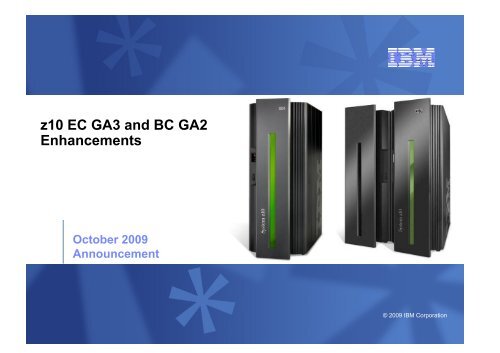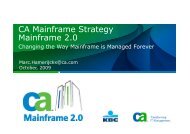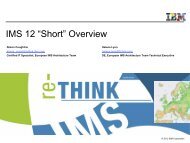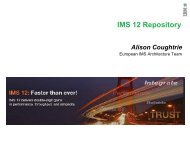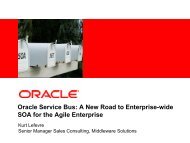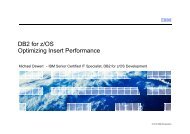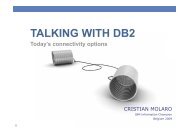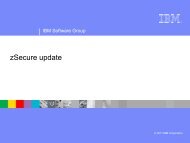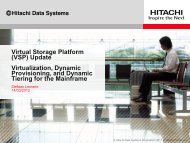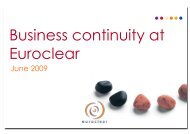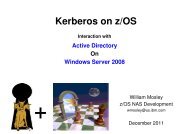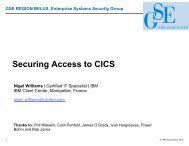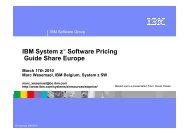System - GSE Belux
System - GSE Belux
System - GSE Belux
You also want an ePaper? Increase the reach of your titles
YUMPU automatically turns print PDFs into web optimized ePapers that Google loves.
z10 EC GA3 and BC GA2<br />
Enhancements<br />
October 2009<br />
Announcement<br />
© 2009 IBM Corporation
Trademarks<br />
The following are trademarks of the International Business Machines Corporation in the United States and/or other countries.<br />
IBM*<br />
IBM logo*<br />
ibm.com<br />
APPN*<br />
CICS*<br />
DB2*<br />
Destination z<br />
eServer<br />
HiperSockets<br />
IMS<br />
Resource Link<br />
RMF<br />
<strong>System</strong> z<br />
<strong>System</strong> z9*<br />
<strong>System</strong> z10<br />
<strong>System</strong> z10 Business Class<br />
WebSphere*<br />
z9*<br />
z10<br />
z10 BC<br />
z10 EC<br />
zSeries<br />
z/VSE<br />
z/Architecture*<br />
z/OS*<br />
z/VM*<br />
* Registered trademarks of IBM Corporation<br />
The following are trademarks or registered trademarks of other companies.<br />
Adobe, the Adobe logo, PostScript, and the PostScript logo are either registered trademarks or trademarks of Adobe <strong>System</strong>s Incorporated in the United States, and/or other countries.<br />
Cell Broadband Engine is a trademark of Sony Computer Entertainment, Inc. in the United States, other countries, or both and is used under license therefrom.<br />
Java and all Java-based trademarks are trademarks of Sun Microsystems, Inc. in the United States, other countries, or both.<br />
Microsoft, Windows, Windows NT, and the Windows logo are trademarks of Microsoft Corporation in the United States, other countries, or both.<br />
Intel, Intel logo, Intel Inside, Intel Inside logo, Intel Centrino, Intel Centrino logo, Celeron, Intel Xeon, Intel SpeedStep, Itanium, and Pentium are trademarks or registered trademarks of Intel<br />
Corporation or its subsidiaries in the United States and other countries.<br />
UNIX is a registered trademark of The Open Group in the United States and other countries.<br />
Linux is a registered trademark of Linus Torvalds in the United States, other countries, or both.<br />
ITIL is a registered trademark, and a registered community trademark of the Office of Government Commerce, and is registered in the U.S. Patent and Trademark Office.<br />
IT Infrastructure Library is a registered trademark of the Central Computer and Telecommunications Agency, which is now part of the Office of Government Commerce.<br />
* All other products may be trademarks or registered trademarks of their respective companies.<br />
Notes:<br />
Performance is in Internal Throughput Rate (ITR) ratio based on measurements and projections using standard IBM benchmarks in a controlled environment. The actual throughput that<br />
any user will experience will vary depending upon considerations such as the amount of multiprogramming in the user's job stream, the I/O configuration, the storage configuration, and the<br />
workload processed. Therefore, no assurance can be given that an individual user will achieve throughput improvements equivalent to the performance ratios stated here.<br />
IBM hardware products are manufactured from new parts, or new and serviceable used parts. Regardless, our warranty terms apply.<br />
All customer examples cited or described in this presentation are presented as illustrations of the manner in which some customers have used IBM products and the results they may have<br />
achieved. Actual environmental costs and performance characteristics will vary depending on individual customer configurations and conditions.<br />
This publication was produced in the United States. IBM may not offer the products, services or features discussed in this document in other countries, and the information may be subject<br />
to change without notice. Consult your local IBM business contact for information on the product or services available in your area.<br />
All statements regarding IBM's future direction and intent are subject to change or withdrawal without notice, and represent goals and objectives only.<br />
Information about non-IBM products is obtained from the manufacturers of those products or their published announcements. IBM has not tested those products and cannot confirm the<br />
performance, compatibility, or any other claims related to non-IBM products. Questions on the capabilities of non-IBM products should be addressed to the suppliers of those products.<br />
Prices subject to change without notice. Contact your IBM representative or Business Partner for the most current pricing in your geography.<br />
IBM <strong>System</strong> z<br />
© 2009 IBM Corporation
IBM <strong>System</strong> z10 Business Class (z10 BC) and<br />
Enterprise Class (z10 EC) – Functions and<br />
Features for October 20, 2009 Driver 79<br />
Crypto Express3<br />
New TKE Workstation with LIC 6.0<br />
High Performance Secure Key<br />
Encryption<br />
z/TPF support for Crypto Express3<br />
Digitally Signed Firmware<br />
OSA Multi-port support for CHPID<br />
type OSC<br />
Capacity for Planned Events (CPE)<br />
enhancement<br />
STP – Enhancements and z/OS<br />
Alerts for error conditions<br />
Statements of Direction<br />
If it’s “mainframe-like” it’s not a “Mainframe”<br />
IBM <strong>System</strong> z<br />
© 2009 IBM Corporation
IBM <strong>System</strong> z10 Enterprise Class (z10 EC ) GA3 and<br />
IBM <strong>System</strong> z10 Business Class (z10 BC ) GA2 –<br />
Key Dates<br />
November 20, 2009<br />
– Crypto Express3<br />
– High Performance Secure Key Encryption<br />
– HMC Fiber Chanel Analyzer<br />
– STP – Enhancements and z/OS Alerts for error conditions<br />
– TKE LIC 6.0<br />
December 31, 2009<br />
– Improved Capacity for Planned Events options<br />
1Q2010<br />
– OSA-Express3 Multi-port support OSA-ICC – CHPID type OSC<br />
January 1, 2010<br />
– New TKE Workstation with LIC 6.0<br />
* All statements regarding IBM future direction and intent are subject to change or withdrawal without notice, and represents goals and objectives only.<br />
IBM <strong>System</strong> z<br />
© 2009 IBM Corporation
Crypto Enhancements<br />
Below is a link to the IBM <strong>System</strong> z Security Web site that contains IBM <strong>System</strong> z10<br />
Cryptographic Performance<br />
http://www-03.ibm.com/systems/z/advantages/security/z10cryptography.html<br />
IBM <strong>System</strong> z<br />
© 2009 IBM Corporation
Single Chip Module<br />
<strong>System</strong> z Crypto History<br />
2001 2002 2003 2004 2005<br />
2006<br />
2007<br />
2008<br />
2009<br />
Cryptographic Coprocessor Facility (CCF)<br />
Cryptographic<br />
Coprocessor<br />
OS/390!<br />
G3, G4, G5, G6, z900, z800<br />
ICSF!<br />
PCI Cryptographic Coprocessor (PCICC)<br />
G5, G6, z900, z800<br />
PCI Cryptographic Accelerator (PCICA)<br />
z800/z900<br />
z990<br />
z890<br />
z990<br />
PCIX Cryptographic Coprocessor<br />
z890<br />
(PCIXCC)<br />
CP Assist for Cryptographic Functions z990 z890 z9 EC z9 BC<br />
Crypto Express2<br />
Crypto Express3<br />
IBM <strong>System</strong> z<br />
new!<br />
z990/z890<br />
z9 EC<br />
Cryptographic Coprocessor Facility – Supports “Secure key” cryptographic processing<br />
PCICC Feature – Supports “Secure key” cryptographic processing<br />
PCICA Feature – Supports “Clear key” SSL acceleration<br />
PCIXCC Feature – Supports “Secure key” cryptographic processing<br />
CP Assist for Cryptographic Function allows limited “Clear key” crypto functions from any CP/IFL<br />
– NOT equivalent to CCF on older machines in function or Crypto Express2 capability<br />
Crypto Express2 – Combines function and performance of PCICA and PCICC<br />
Crypto Express3 – PCI-e Interface, additional processing capacity with improved RAS<br />
z9 BC<br />
z10 EC/BC<br />
z10 EC/BC<br />
z10 EC/BC<br />
© 2009 IBM Corporation
z10 – Protected key CPACF – a blending clear<br />
key and secure key cryptography<br />
Clear versus Secure Keys<br />
The security of encryption relies upon keeping the value of the key a secret. A<br />
secure key is simply a key that has been encrypted under another key, usually the<br />
master key. A clear key is a key that has not been encrypted under another key and,<br />
therefore has no additional protection within the cryptographic environment.<br />
The CPACF enhancement is designed to:<br />
Help facilitate the continued privacy of key material when used by the CPACF for<br />
high performance data encryption.<br />
Provide additional security for cryptographic keys.<br />
Leverage the unique z/Architecture ® and helps to ensure that key material is not<br />
visible to applications or operating systems when used for encryption operations.<br />
Provide significant throughput for large volumes of data and low latency for small<br />
blocks of data.<br />
Enhance the information management tool, IBM Encryption Tool for IMS and<br />
DB2 ® Databases, by improving performance for protected key applications.<br />
IBM <strong>System</strong> z<br />
© 2009 IBM Corporation
z10 Crypto Express3 – Hardware Design<br />
Crypto Express3<br />
– One or two Coprocessor features. One Coprocessor feature for z10 BC only<br />
– Each processor can be defined as a Cryptographic Coprocessor or an Accelerator<br />
– A minimum of two features must be ordered<br />
Integrated and duplicated Processors into field-programmable gate array (FPGA) to<br />
support Common Cryptographic Architecture (CCA)<br />
Specialized hardware to perform DES, TDES, AES, RSA, SHA1 and SHA-2<br />
cryptographic operations<br />
– SHA-2<br />
SHA-2 (256-bit) hardware based on FIPS PUB 180-2 Secure Hash Standard<br />
SHA-256 is intended to provide 128 bits of security against collision attacks<br />
– RSA<br />
Two 2048-bit RSA engines are designed to provide improved performance for symmetric and<br />
asymmetric operations<br />
Separate Service Processor<br />
PCI-express (PCI-e)<br />
Designed to provides a state-of–the art tamper sensing and responding,<br />
programmable hardware to protect the cryptographic keys and sensitive custom<br />
applications<br />
The tamper-resistant hardware security module, which is contained within the Crypto<br />
Express3, is designed to meet the FIPS 140-2 Level 4 security requirements for<br />
hardware security modules<br />
IBM <strong>System</strong> z<br />
© 2009 IBM Corporation
z10 Crypto Express3 (logical view)<br />
Integrated/Duplicate Processors<br />
runs Common Crypto Arch (CCA)<br />
2 boards<br />
Separate<br />
Service<br />
Processor -<br />
Concurrent<br />
Code<br />
Update<br />
FLASH<br />
SP<br />
DRAM<br />
CPU<br />
DRAM<br />
BBRAM<br />
CPU<br />
CPU CPU<br />
I/F Logic<br />
SP<br />
Core Functions<br />
Tamper<br />
Detection<br />
RTC<br />
Secure<br />
Boundary<br />
+AES<br />
+RSA<br />
processor<br />
Core<br />
USB<br />
Serial<br />
PCI express<br />
PCI x I/F<br />
x4<br />
+SHA<br />
Interface changed to PCI-e<br />
IBM <strong>System</strong> z<br />
© 2009 IBM Corporation
z10 Crypto Express3 feature highlights<br />
Dynamic power management to maximize RSA performance while<br />
keeping within temperature limits of the tamper-responding<br />
package<br />
Virtualization: all logical partitions (LPARs) in all Logical Channel<br />
Subsystems (LCSSs) have access to the Crypto Express3 feature,<br />
up to 32 LPARs per feature<br />
Designed for improved reliability, availability and serviceability<br />
(RAS)<br />
Secure code loading that enables the updating of functionality<br />
while installed in application systems<br />
Executes its cryptographic functions asynchronously to a Central<br />
Processor (CP) operation in <strong>System</strong> z10 BC and z10 EC servers<br />
Continued<br />
IBM <strong>System</strong> z<br />
© 2009 IBM Corporation
z10 Crypto Express3 features highlights<br />
Lock-step-checking of dual CPUs for enhanced error detection and<br />
fault isolation of cryptographic operations performed by<br />
coprocessor when a PCI-E adapter is defined as a coprocessor<br />
Dynamic addition / configuration of cryptographic features to<br />
logical partitions without an outage<br />
Updated cryptographic algorithms used in loading the Licensed<br />
Internal Code (LIC) with the TKE workstation to keep in step with<br />
current recommendations for cryptographic strength<br />
Support for smart card applications using Europay, MasterCard<br />
Visa specifications<br />
Health Monitoring of mesh, temperature, voltage, soft tamper and<br />
low battery<br />
IBM <strong>System</strong> z<br />
© 2009 IBM Corporation
z10 Crypto Express3 defined as a<br />
Cryptographic Coprocessor<br />
When one or both of the two PCI-E cryptographic adapters are configured as a<br />
coprocessor can be used to:<br />
– Encrypt and decrypt data by utilizing secret-key algorithms. Algorithms supported for data<br />
confidentiality are:<br />
• Double-length key DES<br />
• Triple-length key DES<br />
• AES algorithms that have 128, 192 and 256-bit data-encrypting keys<br />
Generate, install, and distribute cryptographic keys securely using both public and secret<br />
key cryptographic methods<br />
Generate, verify, and translate personal identification numbers (PINs)<br />
Generate, verify, and translate 13- through 19- digit personal account numbers (PANs).<br />
Ensure the integrity of data by using message authentication codes (MACs), hashing<br />
– Algorithms, and Rivest-Shamir-Adelman (RSA) public key algorithm (PKA) digital<br />
– Signatures<br />
Key management using TDES, RSA or other security based algorithmic processes<br />
Highly secure encryption processing, use of secure encrypted key values, and User<br />
Defined Extensions (UDX) to CCA<br />
Secure remote key loading of encryption keys to ATMs, point of sale terminals (POS) and<br />
PIN entry devices<br />
Cryptographic key exchanges between IBM CCA and Non-CCA servers<br />
Generation of high quality random numbers for keys and other cryptographic<br />
applications<br />
IBM <strong>System</strong> z<br />
© 2009 IBM Corporation
z10 Crypto Express3 defined as an Accelerator<br />
When one or both of the two PCI-E cryptographic adapters are<br />
configured as an accelerator, the Crypto Express3 feature can be<br />
used for:<br />
– High performance clear-key RSA functions<br />
– Acceleration of modular arithmetic operations, that is, the RSA cryptographic<br />
operations used with the SSL/TLS protocol.<br />
– Offloading compute-intensive RSA public-key and private-key cryptographic<br />
operations employed in the SSL protocol<br />
Supported functions include:<br />
– PKA Decrypt (CSNDPKD), with PKCS-1.2 formatting<br />
– PKA Encrypt (CSNDPKE), with zero-pad formatting<br />
– PKA Digital Signature Verify<br />
– The RSA encryption and decryption functions support key lengths of 512 bits<br />
to 4,096 bits, in the Modulus Exponent (ME) and Chinese Remainder<br />
Theorem (CRT) formats.<br />
IBM <strong>System</strong> z<br />
© 2009 IBM Corporation
New Trusted Key Entry Workstation with<br />
Licensed Internal Code (LIC) 6.0<br />
The Trusted Key Entry (TKE) workstation is a combination of hardware and<br />
software, network-connected to the server, and designed to provide a securityrich,<br />
flexible method for master and operational key entry as well as local and<br />
remote management of the cryptographic coprocessor<br />
The TKE workstation has one Ethernet port and supports connectivity to an<br />
Ethernet Local Area Network (LAN) operating at 10 and 100 Mbps<br />
– The workstation includes a system unit, mouse, keyboard, flat panel display, DVD-<br />
RAM drive to install Licensed Internal Code (LIC), and a PCI-X Cryptographic<br />
Coprocessor<br />
– The workstation has one Ethernet port and a USB port for attaching a Smart Card<br />
Reader.<br />
– TKE workstations can also be used to control the z9 BC, z9 EC, z10 BC and z10<br />
EC servers<br />
TKE FC 0840 will be available on IBM <strong>System</strong> z9 ® Business Class (z9 BC) and<br />
Enterprise Class (z9 EC), z10 BC and z10 EC servers, beginning January 1, 2010<br />
If Trusted Key Entry is required on z10 BC and z10 EC, then a TKE workstation<br />
must be used<br />
IBM <strong>System</strong> z<br />
© 2009 IBM Corporation
z10 Trusted Key Entry 6.0 Licensed Internal<br />
Code (LIC)<br />
Usability enhancements<br />
Includes stronger cryptography encryption for TKE protocols inbound /<br />
outbound authentication.<br />
The TKE uses cryptographic algorithms and protocols in communication with<br />
the target cryptographic adapters in the host systems it administers.<br />
The following enhancements have been made in this area:<br />
Authentication<br />
TKE Certificate Authorities (CAs) initialized on a TKE workstation with TKE 6.0 LIC can issue<br />
certificates with 2048-bit keys. Previous versions of TKE used 1024-bit keys<br />
Transport keys<br />
The transport key used to encrypt sensitive data sent between the TKE workstation and a<br />
Crypto Express3 coprocessor has been strengthened from a 192-bit TDES key to a 256-bit<br />
AES key<br />
Signature keys<br />
The signature key used by the TKE workstation and the Crypto Express3 coprocessor has<br />
been strengthened from 1024-bit key to a 4096-bit key. Replies sent by a Crypto Express3<br />
coprocessor on the host are signed with a 4096-bit key<br />
IBM <strong>System</strong> z<br />
© 2009 IBM Corporation
Trusted Key Entry 6.0 Smart Card Support<br />
The TKE 6.0 LIC contains support to increase the key strength for<br />
TKE Certificate Authority (CA) smart cards, TKE smart cards, and<br />
signature keys stored on smart cards from 1024-bit to 2048-bit<br />
strength<br />
Only smart cards ( FC 0884) with smart card reader (FC 0885)<br />
support the creation of TKE Certificate Authority (CA) Smart Cards,<br />
TKE smart cards, or signature keys with the new 2048-bit key<br />
strength. Smart cards (FC 0888) and smart card readers (FC 0887)<br />
will continue to work with the 1024-bit key strength<br />
IBM <strong>System</strong> z<br />
© 2009 IBM Corporation
Crypto Express2 to Crypto Express3 Migration<br />
Wizard for migrating Crypto Express2 and Crypto Expres3<br />
configuration data<br />
– A wizard is now available to allow users to collect configuration data from a<br />
Crypto Express2 and Crypto Express3 coprocessor and migrate the data to a<br />
different Crypto Express coprocessor.<br />
– The target crypto Express coprocessor must have the same or greater<br />
capabilities<br />
– User benefits include the following:<br />
• Reduces migration steps thereby minimizing user errors<br />
• Minimizes the number of user "clicks"<br />
• Significantly reduces migration task duration<br />
IBM <strong>System</strong> z<br />
© 2009 IBM Corporation
z10 Crypto Express 3 – UDX<br />
UDX (User Defined eXtension)<br />
– Extends the functionality of IBM’s CCA (Common Cryptographic Architecture)<br />
application program<br />
• Customized cryptographic verb controls per customer<br />
– Can’t mix/match UDX definitions across Crypto Express 2 & Crypto Express 3<br />
• HMC/SE panels ensure that UDX files are applied to appropriate Crypto<br />
card type<br />
UDX toolkit for <strong>System</strong> z with Crypto Express3<br />
The following are the User Defined Extension (UDX) Requirements<br />
for migration to Crypto Express3<br />
– Upgrade of crypto card code to CCA level 4.0 ... (few changes from CCA<br />
release 3.30)<br />
– Upgrade of z/OS Service Routine for HCR7770 (major changes)<br />
IBM <strong>System</strong> z<br />
© 2009 IBM Corporation
Software requirements for z10 GA3 Crypto features<br />
Crypto Express3 and Crypto Express3-1P requires at a minimum:<br />
– z/OS V1.9, z/OS V1.10 or z/OS V1.11 with the Cryptographic Support for z/OS<br />
V1R9-V1R11 Web deliverable planned to be available November 20, 2009<br />
– z/VM ® V5.3 with PTFs for guest exploitation<br />
– z/VSE V4.2 and IBM TCP/IP for VSE/ESA V1.5.0 with PTFs<br />
– z/TPF V1.1 (acceleration mode only)<br />
– Linux on <strong>System</strong> z distributions:<br />
Current Novell SUSE and RedHat distributions support the same functionality<br />
as Crypto Express2. Secure key is not supported<br />
Note: z/OS V1.9, z/OS V1.10 or z/OS V1.11 with the Cryptographic Support for z/OS<br />
V1R9-V1R11 Web deliverables may be obtained at:<br />
http://www.ibm.com/systems/z/os/zos/downloads/<br />
IBM <strong>System</strong> z<br />
© 2009 IBM Corporation
STP – Enhancements and z/OS Alerts for<br />
error conditions<br />
IBM <strong>System</strong> z<br />
© 2009 IBM Corporation
STP – Improved <strong>System</strong> Management with new<br />
z/OS messaging<br />
Previously<br />
– If ETS failure condition is detected for STP-only CTN configuration<br />
• Hardware message generated<br />
• No z/OS message generated, possibly delaying problem<br />
determination and correction<br />
<strong>System</strong> management enhancement<br />
– A z/OS message will be issued when an STP alert is raised<br />
• Message indicates event that caused the alert<br />
• z/OS Alerts for error conditions examples<br />
- Operator alerts to z/OS console as well as HMC for STP related<br />
hardware & timing events<br />
- Dial-out time service outside allowable tracking range<br />
- Dial-out access failure<br />
- NTP server failure<br />
- NTP servers unsynchronized<br />
– z/OS V1.11<br />
– z/OS V1.10 and z/OS V1.9 WITH PTFs )<br />
Not available on z990 and z890<br />
IBM <strong>System</strong> z<br />
© 2009 IBM Corporation
Capacity for Planned Events (CPE) enhancement<br />
IBM <strong>System</strong> z<br />
© 2009 IBM Corporation
z10 CPE offering Enhancements<br />
Current CPE offering has one fixed price, regardless of engines<br />
activated<br />
– Customer has access to all dormant engines<br />
The revised offering enables customer to choose the amount of<br />
capacity they want to order with CPE.<br />
– It is priced based on the capacity selected<br />
– The duration is still be limited to 3 days<br />
Generally CPE is priced the same as On/Off CoD<br />
– The difference in using CPE over On/Off CoD is that CPE is a replacement<br />
capacity offering, there are no delta SW charges<br />
– Unlike On/Off CoD, for previously purchased capacity i.e unassigned engines<br />
there is a charge for using it. All CP and IFL capacity is priced at a constant rate<br />
Billing of CPE is done in the same way as prepaid On/Off CoD<br />
– In addition to the CPE record Feature Code 6833, a quantity of the "token"<br />
Feature Codes 0116-0128 will also be included. These will be based on the<br />
number, types, and capacity levels of the engines selected<br />
IBM <strong>System</strong> z<br />
© 2009 IBM Corporation
z10 CPE HMC example<br />
Fields will now be<br />
limited by new<br />
CPE record<br />
IBM <strong>System</strong> z<br />
© 2009 IBM Corporation
SE and HMC Enhancement<br />
IBM <strong>System</strong> z<br />
© 2009 IBM Corporation
z10 HMC/SE Digitally Signed Firmware<br />
IBM needs to prove to customers that no malware can be installed on<br />
their <strong>System</strong> z products during firmware updates<br />
Compliance with Federal Information Processing Standard (FIPS) 140-2<br />
Level 1 for crypto LIC changes<br />
Firmware update files for the HMC/TKE and SE will be digitally signed<br />
– Using a hash algorithm, a message digest will be generated from the<br />
original file. The message digest then will be encrypted with a private key<br />
to produce the digital signature.<br />
– The signature assures that any changes made to the data that has been<br />
signed cannot go undetected<br />
IBM <strong>System</strong> z<br />
© 2009 IBM Corporation
z10 HMC Optional Password Requirement on<br />
Disruptive Confirmation<br />
Analysis of HMC/SE confirmation panels for disruptive actions<br />
found<br />
– Inconsistencies across those panels<br />
– HMC 2.10.1: Areas of improvement needed to ensure impact of action is<br />
not taken lightly.<br />
• Attention indicators at top of panel<br />
• List of objects affected by action<br />
Could be target<br />
Could be secondary objects (i.e., LPAR(s) if the target is CPC)<br />
• Input of user password<br />
HMC 2.10.2<br />
– Allow input of user password on disruptive confirmation to be optional<br />
General recommendation<br />
– Require input of password<br />
IBM <strong>System</strong> z<br />
© 2009 IBM Corporation
Fiber Channel Analyzer<br />
HMC Task providing aggregate view of Fiber Channel Errors across<br />
CECs being managed by HMC<br />
– Analysis to attempt to pinpoint suspected link and control unit problems<br />
– Analyzing IFCCs (Interface Control Checks) on Fiber Network<br />
– Error information containing<br />
• PCHID<br />
• CSS.CHPID<br />
• Channel Type<br />
• Source Link Address<br />
• Destination Link Address<br />
IBM <strong>System</strong> z<br />
© 2009 IBM Corporation
OSA-Express3 Enhancements<br />
IBM <strong>System</strong> z<br />
© 2009 IBM Corporation
z10 OSA-Express3 1000BASE-T, OSA-ICC<br />
1000BASE-T Ethernet<br />
Two and Four ports per feature options<br />
– RJ45, Cat 5 UTP, up to 100 meters (328 feet)<br />
– Two ports* per PCI-E adapter/CHPID<br />
– CHPIDs Supported<br />
OSC (OSA-Integrated Console)<br />
OSD (TCPIP Layer 2 and Layer 3)<br />
OS PTF required to use 2 nd port<br />
OSE (Non-QDIO TCPIP and SNA/APPN ® )<br />
OSN (OSA-Express for NCP)<br />
New microprocessor and hardware data<br />
router<br />
– Large send for IPv4 traffic<br />
– Checksum offload<br />
– Concurrent LIC update<br />
– Auto-negotiation 10/100/1000<br />
– Packet construction, inspection and routing<br />
performed in hardware<br />
IBM <strong>System</strong> z<br />
PCI-E<br />
PCI-E<br />
FC 3367 1000BASE-T, 4 ports<br />
(FC 3369 – 2 ports)<br />
Notes:<br />
For CHPID type OSC, OSD, OSE, both<br />
ports on each PCI-E adaptor are used<br />
Each PCI-E adaptor can be defined as the<br />
same or different CHPID type<br />
Driver 79 provides the code for 2 ports per<br />
PCI-E adapter/CHPID exploitation of OSA-<br />
Express3 1000BASE-T CHPID type = OSC<br />
© 2009 IBM Corporation
z10 OSA-Express3 optimized latency mode (OLM)<br />
QDIO optimized latency mode (OLM) can help improve performance for<br />
applications that have a critical requirement to minimize response times for<br />
inbound and outbound data. OLM optimizes the interrupt processing as follows:<br />
– For inbound processing, the TCP/IP stack looks more frequently for available data to process,<br />
ensuring any new data is read from the OSA-Express3 without requiring additional program<br />
controlled interrupts (PCIs).<br />
– For outbound processing, the OSA-Express3 also looks more frequently for available data to<br />
process from the TCP/IP stack, thus not requiring a Signal Adapter (SIGA) instruction to<br />
determine if more data is available.<br />
OLM is supported by Communications Server for z/OS V1R11 with any OSA-<br />
Express3 feature on <strong>System</strong> z10<br />
This enhancement applies exclusively to OSA-Express3 QDIO mode (CHPID<br />
type OSD)<br />
IBM <strong>System</strong> z<br />
© 2009 IBM Corporation
Statements of Direction<br />
All statements regarding IBM's plans, directions, and intent are subject to change or withdrawal without notice. Any reliance<br />
on these statements of general direction is at the relying party's sole risk and will not create liability or obligation for IBM.<br />
IBM <strong>System</strong> z<br />
© 2009 IBM Corporation
Statements of Direction – October 2009<br />
Power Sequence Controller (PSC) feature quantities:<br />
– The optional PSC feature provides the ability to turn on and off specific control<br />
units from the central processor complex (CPC). IBM intends to make three<br />
changes in the area of PSC support:<br />
1. IBM intends for <strong>System</strong> z10 to be the last platform to support greater than two<br />
Power Sequence Controller (PSC) features (#6501).<br />
2. <strong>System</strong>s with water-cooling will further limit the maximum quantity of PSC<br />
features to one.<br />
3. IBM intends for <strong>System</strong> z10 to be the last platform to allow the PSC feature to<br />
be ordered individually when not part of a new-build server or when not part<br />
of a box MES<br />
Support for optional overhead cabling:<br />
– On future <strong>System</strong> z servers, IBM intends to support optional overhead cabling.<br />
This would be applicable to some data center environments and would apply to<br />
cabling for I/O (fiber optic and 1000BASE-T Ethernet). Overhead cabling is<br />
designed to provide an additional option and increased flexibility; to help remove<br />
floor hazards in a non-raised floor environment and to help increase air flow in a<br />
raised-floor environment.<br />
All statements regarding IBM's plans, directions, and intent are subject to change or withdrawal without notice. Any reliance<br />
on these statements of general direction is at the relying party's sole risk and will not create liability or obligation for IBM.<br />
IBM <strong>System</strong> z<br />
© 2009 IBM Corporation
Statements of Direction – October 2009<br />
Removal of specific smart card features:<br />
– The IBM <strong>System</strong> z10 EC and <strong>System</strong> z10 BC will be the last platforms to<br />
support smart card FC 0888 and the FC 0887 smart card reader. The FC<br />
0888 smart card has been replaced by the FC 0884 smart card. The FC 0887<br />
smart card reader has been replaced by the FC 0885 smart card reader. The<br />
FC 0885 smart card reader and the FC 0884 smart card were made available<br />
on October 28, 2008.<br />
– Customers should begin to migrate information from the FC 0888 smart card<br />
to the FC 0884 smart card to prepare for the change. Refer to the "Trusted<br />
Key Entry PCIX Workstation User's Guide" for instructions on how to make<br />
backups of TKE Certificate Authority (CA) smart cards and how to move key<br />
material from one TKE smart card to another.<br />
Removal of Crypto Express2 feature:<br />
– The IBM <strong>System</strong> z10 EC and z10 BC will be the last servers to offer Crypto<br />
Express2 (FC 0863) as a feature, either as part of a new-build order, or<br />
carried forward on an upgrade.<br />
All statements regarding IBM's plans, directions, and intent are subject to change or withdrawal without notice. Any reliance<br />
on these statements of general direction is at the relying party's sole risk and will not create liability or obligation for IBM.<br />
IBM <strong>System</strong> z<br />
© 2009 IBM Corporation
End of Presentation<br />
ZSP03242-USEN-00<br />
IBM <strong>System</strong> z<br />
© 2009 IBM Corporation


